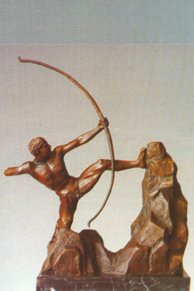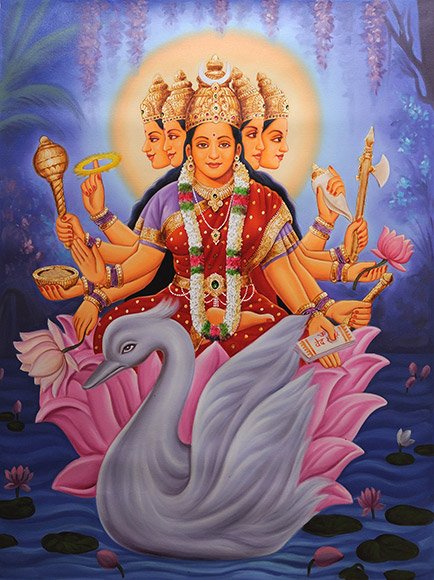Naraca, Nārāca, Narāca: 21 definitions
Introduction:
Naraca means something in Hinduism, Sanskrit, Jainism, Prakrit, Buddhism, Pali. If you want to know the exact meaning, history, etymology or English translation of this term then check out the descriptions on this page. Add your comment or reference to a book if you want to contribute to this summary article.
Alternative spellings of this word include Naracha.
In Hinduism
Dhanurveda (science of warfare)
Source: Wisdom Library: DhanurvedaNārāca (नाराच) refers to a weapon (“iron arrow”). It is a Sanskrit word defined in the Dhanurveda-saṃhitā, which contains a list of no less than 117 weapons. The Dhanurveda-saṃhitā is said to have been composed by the sage Vasiṣṭha, who in turn transmitted it trough a tradition of sages, which can eventually be traced to Śiva and Brahmā.

Dhanurveda (धनुर्वेद) refers to the “knowledge of warfare” and, as an upaveda, is associated with the Ṛgveda. It contains instructions on warfare, archery and ancient Indian martial arts, dating back to the 2nd-3rd millennium BCE.
Chandas (prosody, study of Sanskrit metres)
Source: Shodhganga: a concise history of Sanskrit Chanda literatureNarāca (नराच) refers to one of the 130 varṇavṛttas (syllabo-quantitative verse) dealt with in the second chapter of the Vṛttamuktāvalī, ascribed to Durgādatta (19th century), author of eight Sanskrit work and patronised by Hindupati: an ancient king of the Bundela tribe (presently Bundelkhand of Uttar Pradesh). A Varṇavṛtta (e.g., narāca) refers to a type of classical Sanskrit metre depending on syllable count where the light-heavy patterns are fixed.

Chandas (छन्दस्) refers to Sanskrit prosody and represents one of the six Vedangas (auxiliary disciplines belonging to the study of the Vedas). The science of prosody (chandas-shastra) focusses on the study of the poetic meters such as the commonly known twenty-six metres mentioned by Pingalas.
Purana and Itihasa (epic history)
Source: archive.org: Puranic EncyclopediaNārāca (नाराच).—A particular type of arrow.
Source: archive.org: Shiva Purana - English TranslationNārāca (नाराच) refers to “iron clubs” (i.e., weapons), according to the Śivapurāṇa 2.2.36. Accordingly, as Brahmā narrated to Nārada:—“on hearing these words of Dakṣa. the gods including Indra set off immediately in their readiness to fight. [...] A great fight ensued between the Devas and the Gaṇas. Those powerful warriors fought with each other with sharp spikes, iron clubs [nārāca] etc.”.

The Purana (पुराण, purāṇas) refers to Sanskrit literature preserving ancient India’s vast cultural history, including historical legends, religious ceremonies, various arts and sciences. The eighteen mahapuranas total over 400,000 shlokas (metrical couplets) and date to at least several centuries BCE.
Ayurveda (science of life)
Rasashastra (Alchemy and Herbo-Mineral preparations)
Source: Wisdom Library: Rasa-śāstraNārāca (नाराच) or Nārācarasa is the name of an Ayurvedic recipe defined in the fourth volume of the Rasajalanidhi (chapter 6, udararoga: belly-related diseases). These remedies are classified as Iatrochemistry and form part of the ancient Indian science known as Rasaśāstra (medical alchemy). However, since it is an ayurveda treatment it should be taken with caution and in accordance with rules laid down in the texts.
Accordingly, when using such recipes (e.g., nārāca-rasa): “the minerals (uparasa), poisons (viṣa), and other drugs (except herbs), referred to as ingredients of medicines, are to be duly purified and incinerated, as the case may be, in accordance with the processes laid out in the texts.” (see introduction to Iatro chemical medicines)

Āyurveda (आयुर्वेद, ayurveda) is a branch of Indian science dealing with medicine, herbalism, taxology, anatomy, surgery, alchemy and related topics. Traditional practice of Āyurveda in ancient India dates back to at least the first millenium BC. Literature is commonly written in Sanskrit using various poetic metres.
Shaktism (Shakta philosophy)
Source: Google Books: ManthanabhairavatantramNārāca (नाराच) refers to a “bow”, according to the Manthānabhairavatantra, a vast sprawling work that belongs to a corpus of Tantric texts concerned with the worship of the goddess Kubjikā.—Accordingly, “Nādamaṅgalyā (Vinayā) is in the north-east. She has the face of a bird and three eyes. She sits on a pig. She has ten arms and is very fierce. In the right hands she holds a sword, lance, bow [i.e., nārāca], double-headed drum, and skeleton; in the left, a dagger, a skull (kādya), trident, fetter, and goad. She has matted hair and is the goddess who bestows boons in the north-east. Worshipped, there is success in whatever one desires. Full of the sixteen energies, she, the guardian of the door, is beautiful”.

Shakta (शाक्त, śākta) or Shaktism (śāktism) represents a tradition of Hinduism where the Goddess (Devi) is revered and worshipped. Shakta literature includes a range of scriptures, including various Agamas and Tantras, although its roots may be traced back to the Vedas.
In Jainism
General definition (in Jainism)
Source: archive.org: TrisastisalakapurusacaritraNārāca (नाराच) refers to the third of the “six varieties of joints” (saṃhanana).—There are 6 varieties of joints; the third kind (nārāca) is joined only by the double mortise.—(cf. Samavāyāṅgasūtra 155, p. 150; Sthānāṅgasūtra 494, p. 357.)
Source: Encyclopedia of Jainism: Tattvartha Sutra 8: Bondage of karmasNārāca (नाराच) refers to “inferior joint” and represents one of the six types of Saṃhanana (bone-joint karma), representing one of the various kinds of Nāma, or “physique-making (karmas)”, which represents one of the eight types of Prakṛti-bandha (species bondage): one of the four kinds of bondage (bandha) according to the 2nd-century Tattvārthasūtra chapter 8. What is meant by inferior joint (nārāca) body-making (nāma) karma? The karmas rise of which cause joints with nails keeping them together are called inferior joints body-making karma.

Jainism is an Indian religion of Dharma whose doctrine revolves around harmlessness (ahimsa) towards every living being. The two major branches (Digambara and Svetambara) of Jainism stimulate self-control (or, shramana, ‘self-reliance’) and spiritual development through a path of peace for the soul to progess to the ultimate goal.
Languages of India and abroad
Pali-English dictionary
Source: BuddhaSasana: Concise Pali-English Dictionarynārāca : (m.) an iron bar.
Source: Sutta: The Pali Text Society's Pali-English DictionaryNārāca, (Sk. nārāca; perhaps for *nāḍāca & conn. with nālīka, a kind of arrow, to nāḷa) an iron weapon, an arrow or javelin M. I, 429; J. III, 322; Miln. 105, 244, 418. —valaya an iron ring or collar (?) Mhvs VII. 20 (Com. “vaṭṭita-assanārāca-pasa”=a noose formed by bending the ends of the n. into a circle). (Page 350)

Pali is the language of the Tipiṭaka, which is the sacred canon of Theravāda Buddhism and contains much of the Buddha’s speech. Closeley related to Sanskrit, both languages are used interchangeably between religions.
Sanskrit dictionary
Source: DDSA: The practical Sanskrit-English dictionaryNarāca (नराच).—Name of a metre of sixteen syllables; भुजङ्गराजभाषितं प्रकीर्णशास्त्रसागरे लघौ गुरौ निरन्तरे सतीह षोडशाक्षरे । प्रताप- तापनिर्जितप्रभाकरप्रकाशहे प्रवृत्तवृत्तराजकं नराचमेव मन्महे (bhujaṅgarājabhāṣitaṃ prakīrṇaśāstrasāgare laghau gurau nirantare satīha ṣoḍaśākṣare | pratāpa- tāpanirjitaprabhākaraprakāśahe pravṛttavṛttarājakaṃ narācameva manmahe) ||
Derivable forms: narācaḥ (नराचः).
--- OR ---
Nārāca (नाराच).—[narān ācāmati ā-cam-ḍa svārthe aṇ , nāram ācāmati vā Tv.]
1) An iron arrow; तत्र नाराचदुर्दिनम् (tatra nārācadurdinam) R.4.41.
2) An arrow in general; सर्वलोहास्तु ये बाणाः नाराचास्ते प्रकीर्तिताः । पञ्चभिः पृथुलैः पक्षैर्युक्ताः सिध्यन्ति कस्यचित् (sarvalohāstu ye bāṇāḥ nārācāste prakīrtitāḥ | pañcabhiḥ pṛthulaiḥ pakṣairyuktāḥ sidhyanti kasyacit) || Dhanur. 73; Rām.3.25.25; कनकनाराचपरंपराभिरिव (kanakanārācaparaṃparābhiriva) K.57.
3) Water-elephant.
4) A road running towards the east; Kāmikāgama 25.3.
Derivable forms: nārācaḥ (नाराचः).
Source: Cologne Digital Sanskrit Dictionaries: Shabda-Sagara Sanskrit-English DictionaryNārāca (नाराच).—m.
(-caḥ) 1. An iron arrow. (E. nāra men, āṅ before, cam to eat or consume, affix ḍa; destroying hosts of men.) 2. A bad or cloudy day. 3. A species of the Dhriti metre. (E. nāra water, ācam to spit, affix ḍa.) f. (-cī) A goldsmith’s scales, a fine or assay balance. E. nārāca an iron arrow, and ṅīṣ diminutive affix; also with kan added in the fem. from, nārācikā f.
(-kā). or narān ācāmati ā + cama-ḍi .
Source: Cologne Digital Sanskrit Dictionaries: Benfey Sanskrit-English DictionaryNārāca (नाराच).— (perhaps nara-añc + a), m. A kind of arrow, Mahābhārata 1, 5522.
Source: Cologne Digital Sanskrit Dictionaries: Cappeller Sanskrit-English DictionaryNārāca (नाराच).—[masculine] a kind of arrow.
Source: Cologne Digital Sanskrit Dictionaries: Monier-Williams Sanskrit-English Dictionary1) Narāca (नराच):—[from nara] m. (√añc) a kind of metre, [Colebrooke] ([varia lectio] nār)
2) Nārāca (नाराच):—m. ([from] ?) an iron arrow, any a°, [Mahābhārata; Kāvya literature] etc. (cf. ardha-)
3) water-elephant (= jalebha), [cf. Lexicographers, esp. such as amarasiṃha, halāyudha, hemacandra, etc.]
4) a bad or cloudy day (?), [cf. Lexicographers, esp. such as amarasiṃha, halāyudha, hemacandra, etc.]
5) n. a kind of metre, [Colebrooke] (cf. nar)
6) a [particular] medicament, [Caraka]
Source: Cologne Digital Sanskrit Dictionaries: Yates Sanskrit-English DictionaryNārāca (नाराच):—(caḥ) 1. m. An iron arrow; cloudy day. f. Goldsmith’s scales.
Source: DDSA: Paia-sadda-mahannavo; a comprehensive Prakrit Hindi dictionary (S)Nārāca (नाराच) in the Sanskrit language is related to the Prakrit words: Ṇarāca, Ṇarāa, Ṇārāya.
[Sanskrit to German]
Sanskrit, also spelled संस्कृतम् (saṃskṛtam), is an ancient language of India commonly seen as the grandmother of the Indo-European language family (even English!). Closely allied with Prakrit and Pali, Sanskrit is more exhaustive in both grammar and terms and has the most extensive collection of literature in the world, greatly surpassing its sister-languages Greek and Latin.
Prakrit-English dictionary
Source: DDSA: Paia-sadda-mahannavo; a comprehensive Prakrit Hindi dictionaryṆarāca (णराच) in the Prakrit language is related to the Sanskrit word: Nārāca.
Ṇarāca has the following synonyms: Ṇarāa.
Prakrit is an ancient language closely associated with both Pali and Sanskrit. Jain literature is often composed in this language or sub-dialects, such as the Agamas and their commentaries which are written in Ardhamagadhi and Maharashtri Prakrit. The earliest extant texts can be dated to as early as the 4th century BCE although core portions might be older.
Kannada-English dictionary
Source: Alar: Kannada-English corpusNāraca (ನಾರಚ):—[noun] = ನಾರಾಚ [naraca].
--- OR ---
Nārāca (ನಾರಾಚ):—
1) [noun] a kind of arrow having iron shaft with five long feathers at one end.
2) [noun] an arrow, in gen.
3) [noun] a long shaft with a pointed metal end used as weapon; a spear.
4) [noun] a metal style with a pointed end for writing on usu. palm leaves.
Kannada is a Dravidian language (as opposed to the Indo-European language family) mainly spoken in the southwestern region of India.
See also (Relevant definitions)
Starts with: Naracacurna, Naracadurdina, Naracaghrita, Naracaka, Naracakragrantha, Naracakravartin, Naracalu, Naracam, Naracamuttirai, Naracanali, Naracandra, Naracandrajyotisha, Naracandrajyotishatippanna, Naracandrapaddhati, Naracandrasuri, Naracarasa, Naracarma.
Ends with: Ardhanaraca, Ratanaraca, Rishabhanaraca, Vajranaraca, Vajrarshabhanaraca, Vajravrishabhanaraca.
Full-text (+4): Naraci, Ardhanaraca, Naraa, Ratanaraca, Narasa, Naracam, Naracacurna, Naracaghrita, Naracarasa, Samhanana, Naracadurdina, Naracaka, Vajrarshabhanaraca, Naracamuttirai, Naracanali, Naracika, Iruppunaracam, Astrasayaka, Nericam, Ghantaka.
Relevant text
Search found 12 books and stories containing Naraca, Nārāca, Narāca, Ṇarāca, Nāraca; (plurals include: Naracas, Nārācas, Narācas, Ṇarācas, Nāracas). You can also click to the full overview containing English textual excerpts. Below are direct links for the most relevant articles:
Nitiprakasika (Critical Analysis) (by S. Anusha)
Trishashti Shalaka Purusha Caritra (by Helen M. Johnson)
Appendix 1.2: types of karma < [Appendices]
Tattva 4: Pāpa (sin) < [Appendix 1.4: The nine tattvas]
Part 2: Divisions of time and description of the Golden Age < [Chapter II]
Ramayana of Valmiki (by Hari Prasad Shastri)
Chapter 45 - Rama and Lakshmana are struck down by Indrajita < [Book 6 - Yuddha-kanda]
Tattvartha Sutra (with commentary) (by Vijay K. Jain)
Verse 9.27 - Definition of meditation (dhyāna) < [Chapter 9 - Stoppage and Shedding of Karmas]
Verse 8.11 - The subdivisions of physique-making or name-karma (nāma) < [Chapter 8 - Bondage of Karmas]
The Skanda Purana (by G. V. Tagare)
Chapter 109 - The Greatness of Cakra Tīrtha < [Section 3 - Revā-khaṇḍa]
Chapter 13 - The Fight between Devas and Asuras < [Section 1 - Kedāra-khaṇḍa]
Chapter 38 - The Glory of Kṣīrakuṇḍa: Kadrū’s Expiation for her Deceitful Action < [Section 1 - Setu-māhātmya]
The Bhagavata Purana (by G. V. Tagare)
Chapter 59(b) - Satyabhāmā defeats Gods < [Book 10 - Tenth Skandha]
Chapter 11 - End of the Battle Between Gods and Asuras at Nārada’s Mediation < [Book 8 - Eighth Skandha]
Chapter 54 - Celebration of Rukmiṇī’s Marriage < [Book 10 - Tenth Skandha]